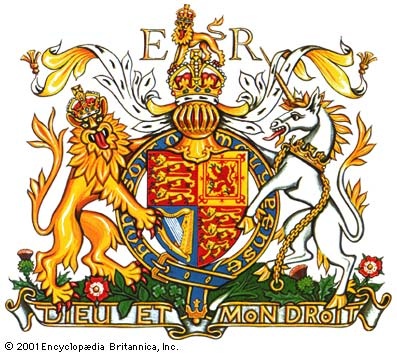arms, coat of
heraldry
 the principal part of a system of hereditary symbols dating back to early medieval Europe, used primarily to establish identity in battle. Arms evolved to denote family descent, adoption, alliance, property ownership, and, eventually, profession.
the principal part of a system of hereditary symbols dating back to early medieval Europe, used primarily to establish identity in battle. Arms evolved to denote family descent, adoption, alliance, property ownership, and, eventually, profession.The origin of the term coat of arms is in the surcoat, the cloth tunic worn over armour to shield it from the sun's rays. It repeated the bearer's arms as they appeared on his banner or pennon and on his shield, and it was particularly useful to the heralds as they toured the battlefield identifying the dead. It also identified the knight in the social surroundings of the tournament. What today is popularly termed a “coat of arms” is properly an armorial or heraldic (heraldry) “achievement” and consists of a shield accompanied by a warrior's helmet, the mantling which protects his neck from the sun (usually slashed fancifully to suggest having been worn in battle), the wreath which secures the mantling and crest to the helmet, and the crest itself (the term for the device above the helmet, not a synonym for the arms). Additions to the achievement may include badges, mottoes, supporters, and a crown or coronet.
The surface of the shield (or escutcheon) is the field. This is divided into chief and base (top and bottom), sinister and dexter (left and right, from the viewpoint of the bearer of the shield, so that sinister is on the right of one facing the shield). Combinations of these terms, together with pale (the centre vertical third) and fess (the centre horizonal third), create a grid of nine points to locate the charges, or designs, placed upon the shield. The centre of the pale in chief is the honour point, the center of the pale in base is the nombril point, and the exact centre of the shield is the fess point.
 The colouring of the shield and the charges it bears developed slowly. When heraldry was confined to display on flags, the tinctures (colours) were the metals or (gold, yellow) and argent (silver, white) and the colours gules (red) and azure (blue). Sable (black) was difficult in the early days because it was derived from an indigo dye that often faded enough to be confused with azure. Vert (green) was then uncommon because it required an expensive dye imported from Sinople (now Sinop, Turkey) on the Black Sea (in French heraldry vert is still termed sinople). Purpure (purple) was even less common, since it was derived from rare shellfish (murex). Later, when shields were routinely decorated with the designs borne on the flags, furs were added to the tinctures, initially those of ermine (from the winter stoat) and vair (from the squirrel). These furs had distinctive patterns that later would be coloured variously to produce such artificial furs as ermines, erminois, and pean. The squirrel's fur, dark on the back and light on the belly, was cut up and assembled into many designs. The terminology is not consistent; while the term tinctures is usually applied to heraldic metals, colours, and furs, some writers restrict it to mean colours only; some use the term colours to mean metals, tinctures (colours), and furs, and others use colours to mean metals and tinctures but treat furs separately.
The colouring of the shield and the charges it bears developed slowly. When heraldry was confined to display on flags, the tinctures (colours) were the metals or (gold, yellow) and argent (silver, white) and the colours gules (red) and azure (blue). Sable (black) was difficult in the early days because it was derived from an indigo dye that often faded enough to be confused with azure. Vert (green) was then uncommon because it required an expensive dye imported from Sinople (now Sinop, Turkey) on the Black Sea (in French heraldry vert is still termed sinople). Purpure (purple) was even less common, since it was derived from rare shellfish (murex). Later, when shields were routinely decorated with the designs borne on the flags, furs were added to the tinctures, initially those of ermine (from the winter stoat) and vair (from the squirrel). These furs had distinctive patterns that later would be coloured variously to produce such artificial furs as ermines, erminois, and pean. The squirrel's fur, dark on the back and light on the belly, was cut up and assembled into many designs. The terminology is not consistent; while the term tinctures is usually applied to heraldic metals, colours, and furs, some writers restrict it to mean colours only; some use the term colours to mean metals, tinctures (colours), and furs, and others use colours to mean metals and tinctures but treat furs separately.In the 17th to 19th centuries, the period known to armorists as “the Decadence,” arms were embellished to record personal or family history, often in ways that ignored the traditions of heraldry's origins. Arms were designed for organizations far removed from war—schools, universities, guilds, churches, fraternal societies, and even modern corporations—to symbolize the meanings of their mottoes or to hint at their histories. During the 20th century, however, there was a return to the classical simplicity of the early heraldic art, exemplified in the medieval rolls that were compiled when arms were slowly being organized into a disciplined system. See also heraldry.
- Putumayo
- Putumayo River
- Puu Kukui
- Puvis de Chavannes, Pierre
- Puya
- Puyallup
- Puyi
- Puyo
- Puzhou
- Pułaski, Kazimierz
- P.V. Narasimha Rao
- P. W. Botha
- Pwyll
- Pyanopsia
- Pyapon
- Pyatakov, Georgy Leonidovich
- Pyat, Félix
- Pyatigorsk
- Pyay
- pycnidium
- Pycnodontiformes
- Pydna, Battle of
- Pye, Henry James
- pyelonephritis
- Pygmalion